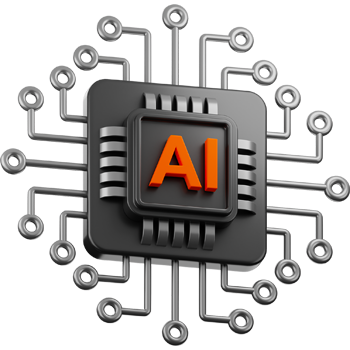

If you’ve ever watched a science fiction film before, you’ve most likely encountered the ‘evil villain’ personification of artificial intelligence (AI). Whether it’s in a filmic depiction of Terminator’s Skynet or Marvel’s Ultron, past portrayals of the relationship between humans and their digital creations have been far from positive.
Now that we’re seeing a significant rise in artificial intelligence applications across multiple industries, the realities of AI and human interaction have ended up on our doorsteps far sooner than many of us had anticipated. With applications in multiple industries, we are left wondering where humans stand in the dawning age of AI automation. Is it an inherently bad thing for workers and creators, or does this technological boom herald a positive future for people everywhere?
We could tell you, but perhaps it is better to allow AI to introduce itself. After all, what better way to understand something than to interact with it?

Here are some of the key takeaways:
AI programs have an incredible range of abilities that make them a great asset, but they also have limitations. For example, a generative language model such as ChatGPT lacks the emotional intelligence and contextual understanding that would allow it to form opinions or create interpretations.
Although AI excels at siphoning information into an easily readable form, its capabilities do not yet extend to interpreting or extrapolating data, or otherwise demonstrating a deeper understanding of the world. These limitations mean that AI cannot entirely replace humans but indicate that it is well-positioned to positively impact many industries.
Before asking what a future with this technology looks like, it must be recognised that we could be far closer to that future than we might think. Early adopters of any new technology often drive the waves of usage. However, there is usually a long period of ‘gestation’ before the technology explodes into commercial popularity.
MIT researcher Erik Brynjolfsson calls this pattern the ‘J-curve’, acknowledging the birth of the idea, the lull of its gestation, and finally its ascent into wider use. From humanity’s first flight to the invention of the internet, historians have observed this pattern over and over, and MIT experts predict that the that the use of AI will scale similarly.
The gestation period has already been happening. Finance, marketing, data security, and even astronomy, are all sectors that require large amounts of data processing, and analysts have already benefitted from the high-functioning presence of specialised AI systems.
Signs of the J-curve’s ascent are appearing too. For example, Google’s VP of Labs Clay Bavor recently left the tech giant in favour of creating an AI startup. In a LinkedIn post, in which he cites his partner in business, Bret Taylor, Bavor writes: “We’re excited to build a new company to apply AI to solve some of the most important problems in business”.
Heeding these signs is crucial, as now is the time to upskill and adapt. With the right adaptations for schools, governments and workplaces, and even individual creators, we can utilise AI to encourage a more technologically advanced, streamlined way of working and living.
However, it is also important to note some of the negative news surrounding the upswing in AI usage. Another Google VP – the so-called ‘Godfather of AI’, Geoffrey Hinton – recently left the company and warned the public about the ‘dangers’ of the artificial intelligence, claiming that it will prompt bigger changes than that of the industrial revolution.
Some of the newest AI systems to enter public use have prompted unrest in creative communities. Applications like AIVA, Midjourney, and Lensa could be seen to eliminate the creative work of human artists, as they are able to produce high-quality concepts for art or music within seconds.

AIVA is an AI-powered soundtrack creator that markets itself as an assistant to creatives who want their projects to have appropriate and atmospheric music. Users can either compose using pre-set styles, or they can upload a piece they love. This second option will prompt the program to generate something with a similar impact. These tracks have no royalties or copyright, meaning that they are free to be used on any and all creative projects.
While this program is potentially a knock for composers, it is also a huge boon for creators on a budget who need music to supplement their games, videos and more. There’s also an argument that this tool can be a great creative assistant for composers themselves, allowing them to form a baseline melody or test a concept without the hours of work that this would otherwise require.

Midjourney is an AI system that runs on Discord. The program takes text prompts from users and spits out unique images that are rendered in the specified style. The art is of incredibly high quality, and as the system is used, it expands its capabilities based on feedback from users.
For artists all around the world, Midjourney represents something of a competitor. Another AI program, Lensa, popped up all over Instagram in 2022, but also populated social media with the question of whether using artificial intelligence to produce art was moral. AI learns by processing large amounts of data; in the case of art, this means processing and analysing human-produced art, and reproducing content based on this data, which some artists consider to be a form of intellectual property infringement.
However, the use of artificial intelligence for art production might also represent a positive change. Using such a platform allows users to translate extremely specific concepts into the visual medium. Artists can render wildly specific reference images, game designers can accompany their pitches with concept art, and web designers can create unique backgrounds to help their clients stand out.
Neither AIVA or Midjourney are programs that are perfect, nor do they exceed the limitations of their form. They still can’t interpret beyond the data pool available to them, even if the data pool expands with every user, and they lack emotional comprehension. However, used well, these tools might be a way for creators to lessen their non-creative and time-consuming tasks, allowing more time for creative thinking.
While understandably unsettling in many ways, and certain to destabilise some industries and their normal processes, the rise of specialised AI programs is unlikely to be a sign of the workforce apocalypse. Instead, this change asks us to do what humans do best, and what AI systems have yet to master: adapt.
By streamlining certain processes, these AI systems open the door to new and exciting ways of working – but only if we are all willing to embrace them. Whether we’re using ChatGPT as a centralised research tool, Midjourney as a source of reference images for artistic exploration, or AIVA to create rhythms that we then enrich with human emotions, there are infinite possibilities available.
Exactly how these technologies will impact humanity remains to be seen, with both positive and negative outcomes hanging in the balance. However, one thing is certain: we’re in the middle of a technological evolution that could carry us into the next century much faster than any of us expected.